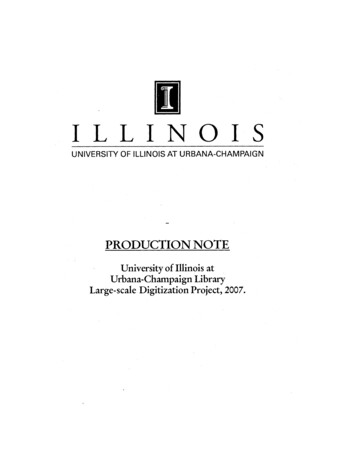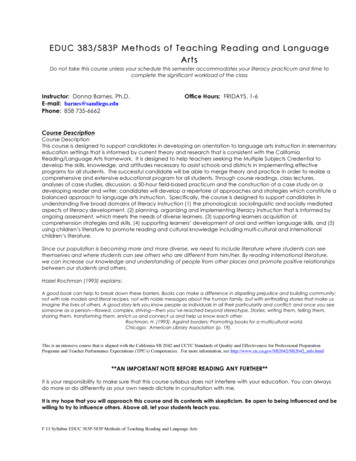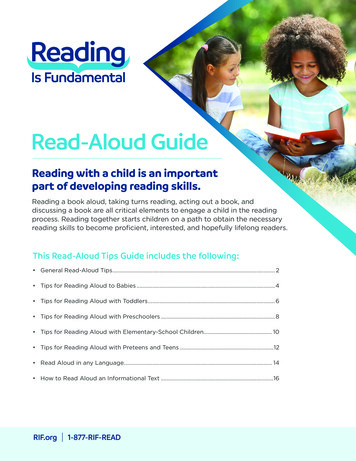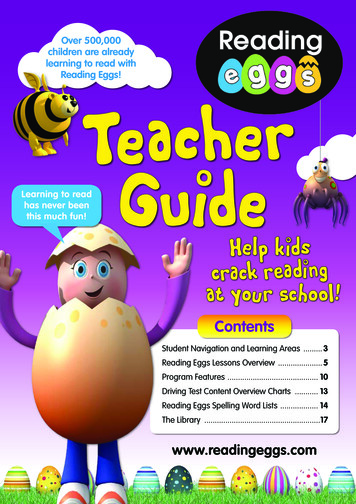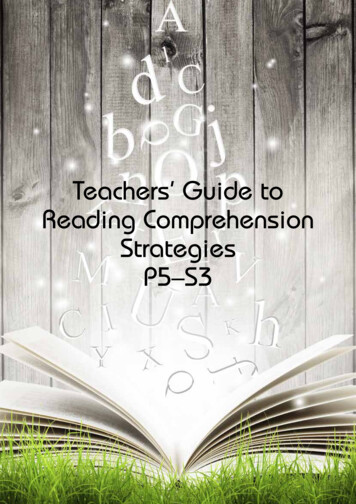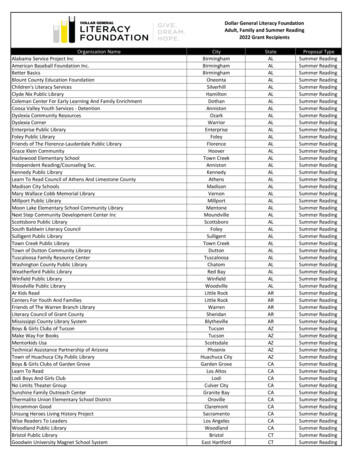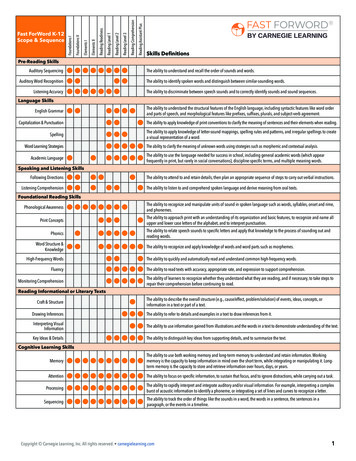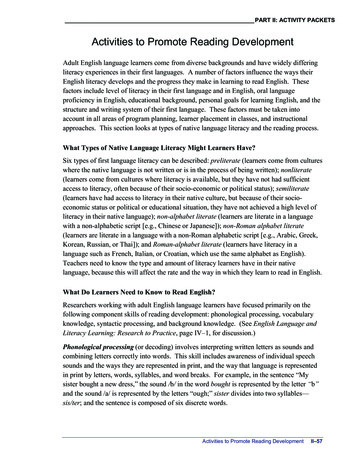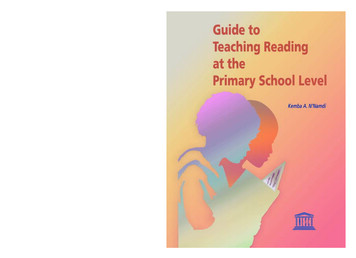
Transcription
Guide toTeaching Readingat thePrimary School LevelKemba A. N’Namdi
The author is responsible for the choice and presentation of the factscontained in this book and for the opinions expressed therein, which arenot necessarily those of UNESCO and do not commit the Organization.Published in 2005by the United Nations Educational,Scientific and Cultural Organization7, place de Fontenoy, 75352 PARIS 07 SPComposed and printed in the workshops of UNESCO UNESCO 2005Printed in France(ED-2005/WS/28CLD 21709)
PREFACEiteracy is the manipulation of thoughts and language to express ideas. It helpsto build an understanding of various texts, people and situations, and promotesself-empowerment. Our global society depends increasingly on literacy as a major factor for progress. Unfortunately, at a time when the ability to read and writeis becoming imperative in order to contribute actively to society, many children donot have access to education. Skills in reading enable learners to benefit from educational activities, and to participate fully in the social and economic activities inwhich they take part. In addition, reading is fundamental to progress and successin all other school subjects (Irwin, 1967).Reading development involves the participation of children, parents, educators and the community as a whole. This manual was developed to assistteachers in teaching reading at the primary school level. It is intended to helpteachers create an educational vision for ensuring reading abilities and develop anedu-cational philosophy based on this vision. This philosophy should ultimatelyassist in the development of the scope and sequence of reading strategies used inthe classroom. Reference is made to reading experts and specialists from as earlyas the 1960s to show that the thinking has persisted over a period of time.This manual is based on the results of work with teacher trainers with thetechnical support of Dr V. Elaine Carter. The reading methods have been complemented by the work of Mavis Irwin in Jamaica, and studies carried out byUNESCO in 1993 in China, Ethiopia, and Jamaica. The materials from thesetexts and others have been compiled to create a general guide to enhance readingachievement at the primary level. The reading programme integrates reading,writing, speaking and listening skills, so that they reinforce each other.Literacy can underlie every aspect of education across the grades, empowering all students to reflect on, and potentially reshape, themselves and their world(Langer, 1995, p. 1). The information in this manual provides a framework tohelp educators facilitate effective reading instruction and enable learners to acquire the necessary tools to become literate.L
The Dakar Framework for Action emanating from the World Education Forum (Dakar, Senegal, April 2000), reiterated the need for all children to haveaccess to good quality primary education. In the 1960s, when many countriesachieved independence, one of the principle concerns was education. However,today over 800 million adults are illiterate worldwide. A generation of adults hasnot been able to benefit from education. The Dakar Framework seeks to helpprepare today’s children to reap the benefits of education, thus creating a newgeneration of literate adults. The target for the Dakar Framework is 100 per centenrolment by 2015.In 1998, over 700 million children were enrolled in school. What differencewould it make if all the children enrolled in schools were permanently literate?By 2015, the school system would have changed the lives of 1.5 billion youngadults.Today, the challenge is to make a dramatic difference in the provision ofeducation, so that the next generation of adults is permanently literate. In taking up this challenge, we cannot ignore the importance of the wider environment and of the community itself. The absence of ready support structures (e.g.libraries, electricity and flourishing publishing industries), language policies inmulti-lingual situations and patterns of communication to reinforce reading arechallenges in many communities. Nonetheless, the school can, and should, playits role as a force for change, ensuring that children not only learn to read, butalso develop good reading habits.In many countries that have long-established education systems, there is aconstant effort towards improving and towards undoing the wrongs of past educational approaches. Today, a lot more is known about the way children learn, thefactors that affect their learning and the ways in which teachers can be most effective in teaching reading. Countries that are new at establishing reading programmesbenefit from not having to reform their educational methods; rather, they are ableto create a reading programme based on the latest and most progressive information from yesterday and today.UNESCO would like to thank Kemba A. N’Namdi for preparing this document as well as all those who worked with her, especially Elaine Carter and JuneWallace.SECTION FOR PRIMARY EDUCATIONDIVISION OF BASIC EDUCATIONEDUCATION SECTOR
CONTENTSINTRODUCTION .CHAPTER 1. PREPARING CHILDREN TO READ .FACTORS .STAGES OF READING DEVELOPMENT .CHAPTER 2. THE READING APPROACH .A VISION FOR ENHANCING READING .READING APPROACHES.CHAPTER 3. CLASSROOM ENVIRONMENT FOR LITERACY LEARNING .MATERIALS .EQUIPMENT .ACCOMMODATION, FURNISHING AND LIGHTING .DISCIPLINE .CHAPTER 4. TEACHING READING FLUENCY: SUGGESTED APPROACHES AND METHODS .SUGGESTED READING PROGRAMME .MULTIPLE INTELLIGENCES .SUGGESTED METHODS AND APPROACHES .WRITING USED TO TEACH READING .STRATEGIES TO FOSTER READING COMPREHENSION .CHAPTER 5. DEVELOPING READING ASSESSMENT .TESTING .OBSERVATIONS .PORTFOLIO ASSESSMENT .QUESTIONING AND INTERVIEWING .SELF-ASSESSMENT .CHAPTER 6. SUGGESTED PROCEDURE FOR DEVELOPING A DIAGNOSTIC 265ACHIEVEMENT TEST .66758284DEVELOPING A READING TEST.APPENDIX. INTEREST INVENTORY .REFERENCES AND FURTHER READING .
As educators, we want students to enjoy reading so that it promotes an interest in other subjects of the curriculum. They should leave the schoolas lifelong readers, writers and learners. Over many decades, educatorshave been drawing attention to the need for effective reading programmes.The purpose of an effective reading programme is to develop the child’s abilityto grasp the meaning of what is read, by teaching him or her how to analyse asequence of ideas and make logical conclusions (Irwin, 1967). The programmeshould appeal to every child, meeting his or her needs, abilities and interests byconstructing a positive attitude towards reading (Irwin, 1967). Teachers shouldbe able to develop clear learning objectives, and the scope and sequence of areading programme that should lead to achieving them. This can be done bythe use of appropriate learning activities, motivational materials and a varietyof teaching approaches in which the children are actively involved.Suggestions are provided on how to prepare pupils to learn to read, andhow to develop and maintain reading achievement. The manual explores various methods and activities that help pupils to maintain and continue to developreading comprehension. Suggestions are made on how to create teacher-madediagnostic and reading comprehension tests. Strategies are given for using assessment as a guide to instruction. It is intended that teachers use this publication as a guide and, to the extent needed, ideas should be modified to suit theneeds of individual classrooms better.If the programme is to address the needs of the pupils, the teachers haveto diagnose, correct and prevent reading difficulties constantly, and/or enrichand refine reading abilities. Teachers’ perceptions and expectations of pupilsshould be positive. They should provide a wide range of experiences to permitall children to learn, and to do so at their own pace (Sweet, 1997). Teachersneed to be constantly alert and to adjust learning experiences according topupils’ progress or level of difficulties, before there is a significant drop in reading performance. Teachers need to develop accurate perceptions of their pupils and re-examine them continually, so they can recognize and act on pupilbehaviour that is inconsistent with their initial expectations. Teachers are alsoresponsible for assessing new methods and approaches to reading against theexperiences and abilities of their pupils.7GUIDE TO TEACHING READING AT THE PRIMARY SCHOOL LEVELINTRODUCTION
8New trends in the use of local languages in the primary grades as the mediafor instruction raise new challenges for the teaching of reading and simultaneously open new avenues for more creativity in the promotion of reading. Moreof the cultural dimensions should be integrated in the teaching and learningprocess, permitting community members to play a more active role in the education of their children.At the primary level, all teachers must be teachers of reading. Regrettably, not all teachers are trained in the techniques of teaching reading. This undoubtedly calls for a review of national policies for the training of teachers. Itis particularly important in the light of the various skills and social issues to beaddressed during the primary cycle of education.The quality and variety of reading materials available to children in manydeveloping countries is a major handicap for ensuring reading competence. Asurvey in which the Association for the Development of Education in Africa(ADEA) participated in 2000 identified pupil to book ratios ranging from 1:1to 1:7, with rural areas having the poorest supplies of books. This situation willnot be changed overnight; however, teachers can, and should, be trained toprepare reading materials along with their pupils. Advancement in the use ofcomputers should be of great assistance but, unfortunately, the teachers whocould benefit most are in the rural areas and have no access to such media. Inthis context, the priority of reading is very much related to other socio-economic priorities in a community.An effective reading programme must be planned to deal with many otherobstacles in and around the school system. They include very large classes,frequent absences, illiterate parents, and few opportunities for reading out ofschool, since it is not a pastime for some communities. The programme should,therefore, include in and out of school activities, and should be sufficientlyflexible to permit pupils/learners to read on their own.This guide should enable teachers to enhance and develop quality readingprogrammes that lead to achievement in recognized and measurable readingoutcomes.
Teachers are the those directly responsible for creating and applying various techniques and strategies that lead to reading comprehension. They should, therefore,be aware of the factors and stages of development that affect a child’s ability to read.Teachers must also be aware of the reading process in order to teach certain concepts appropriate to the child’s maturity and ability.A child’s initial contact with words and symbols happens before going to school.The first exposure a child has to literacy is at home and in the community. Attitudesand values are directly and indirectly taught, and influence what the child perceivesas relevant and important to his or her personal success. As a child grows older andbegins to go through different stages of reading development, a number of otherfactors could also influence success in learning to read. These factors determinethe reading readiness: parents and the family environment, the child’s attitudes andvalues, and teachers.GUIDE TO TEACHING READING AT THE PRIMARY SCHOOL LEVELChapter 1. Preparing children to read9
Chapter 1. Preparing children to read10FactorsParents and family backgroundParents and the family environment play a significant role in preparingchildren to read. Parents are the first teachers and spend the longesttime with them (Morrow, 1995). They provide the intellectual stimulation and the emotional atmosphere essential to reading achievement(Irwin, 1967). The characteristics of homes have been found to be more closely related to measures of scholastic achievement, particularly in reading, than to measuresof general ability or verbal ability. Such practices as shared reading, reading aloud,making print materials available and promoting positive attitudes towards literacy inthe home, have been found to have a significant effect on children’s literacy (Morrow,1995, p. 7).Parents who practise literacy at home with their children tend to participate inthe academic progress of their children by, for example, helping with homework andreading with their children. Such parents tend to monitor the academic progress oftheir children by talking with teachers about their children’s progress and observing their children work at home. Those who do not value reading or education asa necessary tool generally do not become involved in the educational progress oftheir children. It is the responsibility of educators to inform parents about the valueof their role in their children’s education and to collaborate and work with parentsin order to help their children better.Parents may need to be taught how to participate constructively in the education of their children. Teachers should invite parents and families to participate inthe literacy process, not only to promote literacy in their children but also to enhance their own literacy (Braun, 1991). It helps to encourage parents to interact andbecome involved with the school system, but it is also important to provide themwith concrete shared activities that can be practised at home.Teachers can create activities specifically for the home environment that engagethe entire family, such as taking a family survey of favourite foods or making a family tree. Where parents are (or may be) illiterate, the home activities should includedrawing. If the teachers could create as much harmony possible between what istaught in the classroom and what the children do and experience outside it, thereading programme could become more meaningful for the children (Auerbach,1995). Teachers could benefit from the help of parents to reinforce the ideas andlessons taught in school. It benefits pupils, parents and teachers where there is parental involvement. The ultimate goal is for parents to be aware and prepared to laythe foundations of literacy for their children before they enter primary school, andthroughout their education, at least at the primary level.
An example of a family activity is illustrated below. This is about favouritefoods. A list of possible foods should be developed in class, before they take the assignment home. The foods that we eat could be drawn.11Name: .Date:.Lesson: Food We EatAssignment: Find the most favourite food eaten in your familyProcedure: Interview your family members. Ask them theirfavourite food and mark an X under the food and onthe same line as their name.INTERVIEW ishMeatFruitGUIDE TO TEACHING READING AT THE PRIMARY SCHOOL LEVELExample of a home activity that involves family participation
Chapter 1. Preparing children to readANSWER SHEET121. Which types of food(s) got the most Xs?.2. Which types of food(s) got the fewest Xs? .3. Which type of food does your family like most?.4. Which type of food does your family like least? .5. Which is the second most favourite food in your family?.Children learn various skills and values from experience. They can learn to collect, present and analyse data. The results of the above exercise can be utilized topromote gender equality and democratic processes. Children can learn to spell newwords. The importance of this approach is that it creates a learning environment inwhich, first, reading embodies various aspects of learning and, second, there is alink between home and the school. Furthermore, the exercise does not depend onthe parents being literate in order to participate in the activity.Other information can be gathered as well from some exercises. For example,the results of an exercise, such as this one, could also help the teacher to understandthe nutritional habits of the pupils and their families. The results may point to theneed for a school-feeding programme.The attitudes and values of the childThe most significant factor in determining the preparation of a childto read is his or her reading readiness. Readiness is determined by thechild’s self-concept, his or her value of education, physiological andpsychological maturity, and a desire to discover reading (Irwin, 1967;Spache, 1963). A child’s self-concept governs the ability to relate to success, andpredict how well he or she will perform a task in their reading performance(Eccles et al., 1983; Irwin, 1967). When children believe that they can accomplisha task, they are more likely to engage in the task, and when faced with challenges,they are more likely to continue working on it until they ultimately complete thetask (Wigfield, 1997; Bandura, 1977).The value of education is associated with the experiences of the child, the importance of education in the home environment and the relevance to the child’spersonal development. Children often inherit values presented to them in their environment. If reading is neither considered a valuable asset, nor has any connectionwith the child’s world, it may not be a priority for the child.
The role of the teacherThe role of the teacher is to be responsive to the vast and varied needs of each child,and to promote an educational climate that facilitates motivation and the desire toread. First, the reading programme must reflect the identity of the children. Thisconnection is achieved by using images that reflect the children’s physical (picturesof people in the community or of the children themselves) and cultural identity. Ifchildren see themselves as contributors, they are able to take responsibility for thereading process.When developing activities for a reading programme, the tasks shouldactivate and extend the pupils’ background knowledge, and should involve real-life issues and interests directly related to the child, and towhat that child believes to be important (Ruddell and Unrau, 1997). Ifthe pupils see literacy as a way of pursuing interests and solving personally relevantproblems, and/or adding to the quality of their lives, they will be more willing toengage in reading and writing and will value them more highly (Turner, 1997, p.192). However, to arrive at this perception, the classroom environment should alsoreflect the children’s orientations and beliefs.The role of the teacher is also to employ various behavioural and teachingstrategies to promote pupil motivation. If children are motivated to learn to read,they will try to learn to read, and continue to do so, even when faced with obstacles.The teacher is responsible for creating an environment that motivates children toread.13GUIDE TO TEACHING READING AT THE PRIMARY SCHOOL LEVELBefore entering school, some children will have reached a certain level of psychological and physiological maturity that enables them to associate relationshipsbetween symbols, sounds and words. These children come to school more preparedto learn to read than those who have not reached a certain level of maturity. Thus allthe multiple components of these factors (experiences, values, maturity and motivation) create a diverse group of learners, each with individual differences in skills,needs, maturity and interests. It is, therefore, unwise to assume that all children areready for whatever the curriculum dictates. The curriculum and the teacher mustmake allowances for differences in children. The learning environment must helpto prepare some children to read by providing them with experiences and contactwith words and symbols, yet begin to develop reading skills in others. This approachis particularly necessary in countries in the South, in which young children are exposed to organized early childhood education programmes. In fact, the first gradeof primary schooling should focus on language development and other aspects ofreading readiness. This investment is bound to pay off in time in the children’s performance in subsequent grades.
Chapter 1. Preparing children to read14The classroom environment should help pupils feel good about who theyare. For example, pupils may be given different classroom duties forwhich they are responsible, such as noting attendance, collecting anddistributing books, and classroom sanitation. Giving responsibilities topupils helps to enhance their leadership skills and qualities.Teachers should communicate positive beliefs and expectations and engagein positive reinforcement towards pupils. Teachers should show that they love andcare about children. Pupils should feel valued and respected and supported by theirteachers.The teacher helps pupils to establish reading goals and expectations appropriate for their respective capacities, and help them reach their goals (Ruddell andUnrau, 1997; Schunk and Zimmerman, 1997). When pupils have reading goals,they are better able to monitor their progress; these accomplishments demonstrateto the pupils that they are capable of performing well, which ultimately enhancestheir beliefs about their abilities, and what they expect from themselves. Positiveself-evaluations of progress increase pupils’ beliefs about their capabilities to learnand sustain their motivation (Bandura, 1977; Schunk and Zimmerman, 1997).Teachers can promote motivation by:Showing enthusiasm about teaching, and by showing interest in their work.Using innovative, creative, clear ways for presenting a concept, providingexamples, and allowing the opportunity to apply concepts in various contexts.Giving learners the opportunity to gain a sense of ownership in the educational process. This means that students participate in decision-making activities that directly affect the classroom environment, such as collectively decidingclass rules. They help to make decisions that affect their education, such asselecting texts to be used in a lesson, and/or giving suggestions about whichactivities will be used in the reading programme.Unfortunately, there is no sure way to determine reading readiness. Each child isinfluenced by a variety of emotional and environmental factors that determine ifthe child is prepared to learn to read. Teachers can help to facilitate or enhance factors that may be underdeveloped in a child, by providing an educational environment that nurtures the children’s intellect, interests, emotional development andskills. It is important to re-emphasize that teachers can help by understanding thatlearners do not reach certain levels of maturity at the same time, and that they havenot had the same experiences. However, this variety among learners, if creativelyutilized by the teacher, can itself be a source of motivational force.
There are generally five stages of reading development and teachers should be awareof what is required at each stage. This awareness helps the teachers to understandwhen, and how, to introduce various techniques into the programme at the various levels of growth and development of pupils. It should be noted that childrentend to master the various stages at different ages. To a large extent, the ability ofchildren to read depends on the quality of the learning environment provided bythe teacher and whether or not the language spoken in the school is the languagespoken by the child at home. Both of these factors can have a dramatic effect onthe time it takes a child to develop in each of the stages. In situations where thelanguage of the child is different, the language spoken in school the first year ofprimary education should be devoted to language development and not to reading.A child cannot learn to read in a language that he or she does not speak. After oneyear of language development (becoming familiar with the language of the institution), the pupil should be better prepared for the reading development programme.1. The pre-reading stageThe first stage of development is the pre-reading stage. The responsibility of theteacher is to encourage reading interest with enjoyable experiences and activities,with an emphasis on oral expression. The principal goal at this stage is to ensurethat the learner is socially, mentally, emotionally and physically ready to learn toread. Spatial development is important at this stage. The pupil is taught to recognizespaces between words and the descending order of the lines in a text. He or shelearns to read from left to right usually, or from right to left for instance in Arabic(Carter, 2000). Oral expression is the focus of instruction, and the developmentof sight vocabulary which is taught using sentences, signs, labels, etc. Simple ideasare expressed and organized in order to create sentences. The formation of words,starting with consonants, and the recognition of rhymes by word endings, are alltaught.Examples of children’s activitiesTelling stories: reading stories with lots of expression, in order to capture the attention of the children. The teacher asks questions about what is going on in the storyas the reading goes along, to make sure that they understand the meaning of thestory.15GUIDE TO TEACHING READING AT THE PRIMARY SCHOOL LEVELStages of reading development
Chapter 1. Preparing children to read16Drawing pictures and afterwards sharing the meaning/content of the picturewith the class: the pupils may draw a picture of something of their choice and thenexplain to the class what is going on in the picture. The picture may be a simple scene(such as a family eating dinner) or it may be a full story. This depends on the pupil.Looking at a painting, a photograph or a drawing, analysing the image and choosing a title: this may be done collectively, as a class, or in smaller groups if the class sizeis very large. Pupils should be able to explain why they chose a specific title.Using pictures and songs to arrive at
Reading development involves the participation of children, parents, edu-cators and the community as a whole. is manual was developed to assist t eachers in teaching reading at the primary school level. It is intended to help teachers create an educational vision for e

